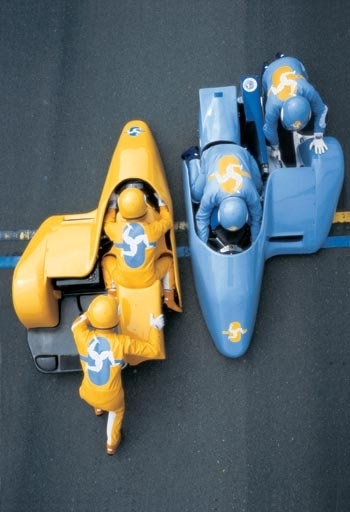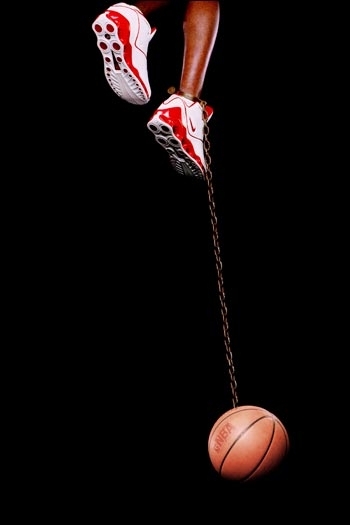Mixed Signals: Artists Consider Masculinity in Sports
–
On Fri., Feb. 4 the Middlebury College Museum of Art will openMixed Signals: Artists Consider Masculinity in Sports, an exhibition of contemporary art that examines the subject of the male athlete. This particular artistic theme is an outgrowth of several decades of discourse about identity and gender. Including such well-known artists as Matthew Barney, Catherine Opie, Collier Schorr, and Sam Taylor-Wood to emerging talents such as Shaun El C. Leonardo and Joe Sola, Mixed Signals demonstrates that the male athlete is a far more ambiguous, multifaceted figure in our collective cultural imagination than ever before. Using elements of wit, sarcasm, and controversy, these artists challenge cultural assumptions that gender is ever natural or innate. Instead, they emphasize the many ways masculinity is always performed, coded, and socially constructed, perhaps even more so in the spectacular, media-saturated field of sports.
Additional artists featured in this exhibition are Mark Bradford, Marcelino Gonçalves, Lyle Ashton Harris, Brian Jungen, Kurt Kauper, Kori Newkirk, Paul Pfeiffer, Marco Rios, and Hank Willis Thomas. The exhibit will remain on view through Sun., Apr. 17.
The foundational figure for this exhibition is American multi-media artist, Matthew Barney, who has mined a range of materials—Vaseline, dumbbells, chalk, and wrestling mats, for example—and imagery—much of it related to football—to highlight the way young men are culturally conditioned by the intimate experience of competitive sport. Barney has isolated themes, imagery, and materials within the culture of sport that hint at related economies of sexuality, objectification, homosociality, and desire, and developed an aesthetic practice to grapple with these difficult themes. Accordingly, Mixed Signals will present screenings of an early film (CREMASTER 4, 1994) and a later film (Drawing Restraint 10, 2005) by Barney, which in combination emphasize the persistence of this theme within the artist’s oeuvre.

Matthew Barney, CREMASTER 4, 1994, 35mm film with sound, 42 minutes. Courtesy Gladstone Gallery, New York
Rituals of male bonding typical to various different sports are explored elsewhere in Mixed Signals. These “homosocial behaviors” (non-sexual expressions of affection and desire, sometimes accompanied by violence) within male-dominated social networks appear in a number of works on view. Here, Shaun El C. Leonardo’s performance-based sculpture and video work is a salient point of reference, as are Marcelino Gonçalves’ sensual paintings of young football stars, and a video work by Joe Sola, of football players sparring with the artist.
Another key theme of this exhibition pertains to the materials, symbols and regalia of sports that signify the prowess of the wearer, and are often construed as synonymous with the identity of the male athlete. Brian Jungen’s mixed media works, for example, rework sports merchandise into suggestive works addressing the artist’s individual identity, while Hank Willis Thomas’s haunting image of a head that has been branded with the Nike swoosh logo, using Photoshop, equates athletes with commercialized products, while simultaneously referencing the practice of branding African-American slaves. The concept of athletic events as gendered theater arises in the works of Paul Pfeiffer and Mark Bradford, as well as in the work of Catherine Opie, whose vivid color photographs of Friday night high school football heighten the dramatized atmosphere. In her individual portraits of the players, she “manages to capture the tentatively constituted self-image of her teenage subjects….[They] hesitate about themselves, aware of the archetypes they aspire to,” in the words of the exhibit’s guest curator Christopher Bedford.

Hank Willis Thomas, Basketball and Chain, 2003, lightjet print, 30 x 20 inches. Courtesy of the artist and Jack Shainman Gallery, New York
Despite all that has changed as a result of the identity politics of the 1970s, ’80s, and ’90s, one American stereotype still remains particularly entrenched: that of the aggressive, hyper-competitive, emotionally undemonstrative, heterosexual male athlete. This subject has, until recently, been overlooked by critically minded artists, critics, art historians, and curators. Adopting methodologies inspired by feminist and queer theory, gender studies, and racial politics, Mixed Signals brings together a significant body of recent work that explores the polyvalent figure of the contemporary male athlete, which has only recently attained sufficient critical mass for such an exhibition to take place.
On April 6 Dave Zirin spoke about “Sports and Resistance in the United States.” If you missed his lecture, you can watch it here.
Mixed Signals is organized by Christopher Bedford, a curator at the Wexner Center for the Visual Arts in Columbus, Ohio. Formerly assistant curator in the department of contemporary art at the Los Angeles County Museum of Art, he is now working on a survey of Silvia Kolbowski’s work. Bedford is on the editorial board of the Los Angeles-based journal X-TRA, and is editing a volume of essays for Duke University Press. He has written extensively on art for publications including Artforum, Art in America, and October.
Mixed Signals: Artists Consider Masculinity in Sports is a traveling exhibition organized and circulated by Independent Curators International (ICI), New York. The exhibition and tour are made possible, in part, by The Horace W. Goldsmith Foundation, the ICI Advocates, the ICI Partners, Agnes Gund, Gerrit and Sydie Lansing, and Barbara and John Robinson. Mixed Signals is an expanded version of Contemporary Projects 11: Hard Targets—Masculinity and American Sports, an exhibition curated by Bedford, which was organized by the Los Angeles County Museum of Art.

e=”ICI_Logo.gif” width=”50” height=”47” />
